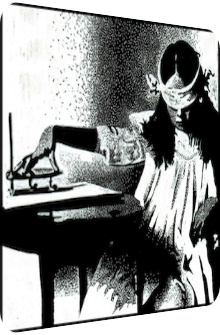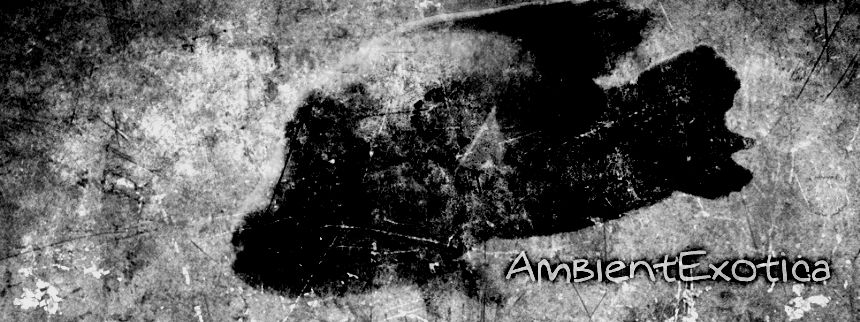
Andreas Brandal
Seance
2014
The medium is the message. Cited millions of times all over the world, Marshall McLuhan’s old tenet is taken to a new level by Bergen, Norway-based Ambient composer Andreas Brandal on his eight-track album Seance, released in February 2014 on Gavin Catling‘s Twice Removed Records and available to fully stream and purchase at Bandcamp in a digital edition or 50 hand-stamped CD-R’s. Here, the medium in form of an unnamed person is the springboard to preternatural sluices. The Australian label specializes on international artists and multitudinous styles, and it so happens that Dark Ambient has always been one prominent cornerstone of its history: releases like Ophion's Sacrosanct and Be My Friend In Exile's The Silence, The Darkness (both 2013) deliver eldritch panoramas made of synths and processed guitars, and Brandal’s work is brewed with the same ingredients. The focus and aesthetic realization, however, is different: Seance is a clear-cut concept album that is less about forsaken wastelands, grinding horror or life-threatening terror than an equilibrated setting. Mysteries and enigmas waft through every corner, even particles of healthy light find their way into the cavernous locale. One specific trick of Brandal’s repertory is worth noting, for it makes his album less of a cloak-and-dagger artifact and rather puts it near a genre that is normally not a distinct part of Dark Ambient in general: Space-Age full of kosmische glitters. Resemblant of another artist and work of Twice Removed Records’ back catalog, Oliwa’s Naturalia (2013), the strongly synthetic pads tumble, twirl and float through the ether. Here is a meticulous look at Seance which is well embedded in Andreas Brandal’s own coinage: “Your guide to the sonic afterlife.”
The first few seconds are on par with the listener’s expectations, only to mock them immediately: brazen clatters paw the ground on the opener Gathering, vaulted scrapes induce a portentous flurry. Portent, meanwhile, turns into virulence when the first Space-Age synth structures take over the scenery. While they warble and wobble like down-pitched theremins, not everything is sinister and eerie per se. In close proximity to the frequency gusts of the AM kind, sun-dappled harpsichord globs illumine the ashen scenery. It is the simultaneity of the cauterized coils, the oscillating blisters and luminescent flashes of euphony that makes this kick-off seem so surreal. The sepia-tinted haze wanes in the second track. Fittingly called Medium, it is eminently colder, supercharged with a braiding of saltatory blotches, helical argentine stardust glitters and mucous flumes multiplexing the weight of the universe in the background. The fluxion thins out, making room for the sound of electric current. This is usually the base for a shift, but Andreas Brandal shies away from unleashing Power Drone or Shoegaze structures and lets the aqueous undercurrent trickle away in a comparably mellifluous way. Progress, on the other hand, is more keen on aerose alkaline prongs. Elasticized to allow an echopraxia of legato washes, the track serves as the supernatural vestibule to the things to come. Medieval lutes of the retrogressive kind boost the pipe dream, feel like a long-lost fugacity and become enmeshed with ophidian adjuvants. The synthetic textures themselves harbor an aggressive core, but it is the beguiling gradient of the tone sequences which make this one a camouflaged, severely transmuted Dream Pop anthem and the – for the moment – last artifact bound to earth. For Seance turns into fiendish climes.
Communicating is the track that changes everything… and hides this fact. It does not feel like antimatter, not at all, as it is well entrapped in the Tartarean tomb. Notwithstanding this assertion, Andreas Brandal creates an allure that leads astray from the perigee and straight into the tumular transcendence. A silvery Ambient track with a sylphlike pith, Communicating is remarkably languorous, superfluously calm with only a modicum of glacial spikes and submarine-like pings towering above the hazy nebula. One should be very afraid, as the communication succeeds and does not sport any kind of recalcitrance, only erudite effulgence. Spirits is next and seems to be opposed to what I just implied, namely that Seance leaves Earth. Church bells and bucolic field recordings prove me wrong, I freely admit it, but they are mere figments, alatoric fragments aquiver with joy which lead to an antrum of anxiety. Metallic susurration, stokehold expectorations, vesiculating heating pipes and a misguided ignis fatuus hue the unreal location in a fallow light. Whereas the following Message bales cavalcades of New Age dark matter pads and opens a short window to the early 70’s and their spacious circumambience, the mucilaginous Ectoplasm activates the Geiger counter, seismograph and dot-matrix printer and slowly leads back to the earthen world of scholarship and science (seance ≠ science), as the awed participant(s) examine and process the epicurean vestige of their daring wrongdoing. Once the staccato chitchat of the electronics wanes, gossamer melodies are injected. They spawn triumph and solemnity. The acroamatic ending with its reciprocating rattles and clangs remains an arcanum though. The finale is fittingly named Conclusion, a deduction of transfiguring acoustic guitar aortas, whitewashed sirens plus an increasing – and definitely planned – chintziness. Spooky heterodynes remind of ancient mansions which turn whiter and paler until the album comes to a halt. The conclusion: man knows nothing. And only survived to cope with this burden.
Andreas Brandal’s Seance teases the listener, and if he or she happens to be a devoted fan of Dark Ambient movement or the adjacent Hauntology craze, this state can become increasingly unbearable as the album progresses. And this very state is, in a Lovecraftian twist, the savior of the album. Like it or not, but Brandal never ever leaves the comfortable habitat of the album’s endemics. The procession itself is shrouded in mystery, enshrined in excitement, alloyed with doubts, but the surfaces and melodies have no heavy liability. It would have been so easy for the Norse artist to astutely augment the hell out of a respective texture, letting it prosper, swell and then mutate until it reaches an oversaturated, overdriven, overabundant, over-whatnot state that grinds the bystander’s bones away, with a following cleansing of the unavoidable medulla splutters. As stated before, this is not the case, at no time during Seance. The sounds, synths and guitars make it possible for both the quiescence and related nebulae to reach into the cryptic world. No histrionic string of events is imposed, no overly cinematic protrusion presented, and no conclusion revealed. Yes, the listener receives a track whose title is Conclusion, but it is not of the rapturous explanatory kind. One does not know what to make of the whole seance: did the ritual work? Was it the first time it took place, and is it about to happen again? How many people or humanoids were involved? These things do not matter, but since Brandal provided the artwork and structured the work as a concept album, it is wise to treat it like that and search for an ultimate, if hopelessly ulterior meaning. The very nature of the topic prevents the listener from gaining it, no spoken words, no demonic messages, not even a fiendish snorting are interwoven. The experience itself is hence improved and interpolated. Dark New Age meets Space-Age, Drone and an infinitesimal capsule of Dream Pop: Seance is as intimate as it is alienating. It opens the mind and closes it all too happily at the same time.
Further listening and reading:
- You can purchase and fully stream Seance at Bandcamp.
- Follow Andreas Brandal and Twice Removed Records on Twitter: @twilightluggage and @twiceremovedrec.
Ambient Review 313: Andreas Brandal – Seance (2014). Originally published on Feb. 5, 2014 at AmbientExotica.com.
